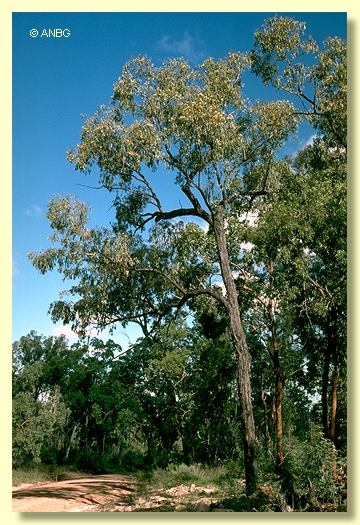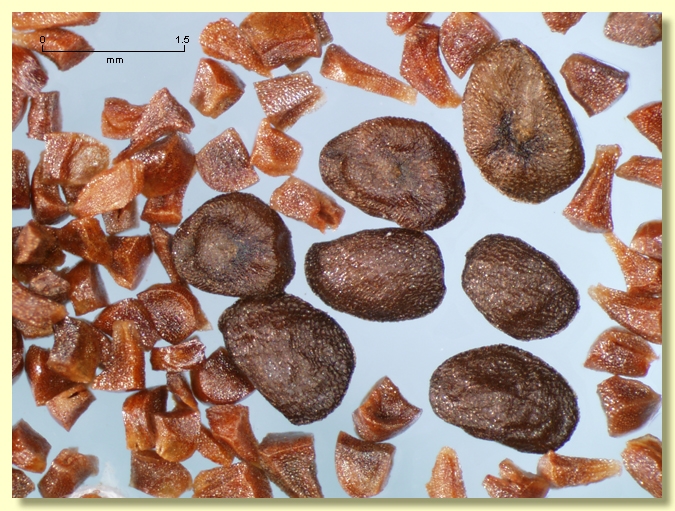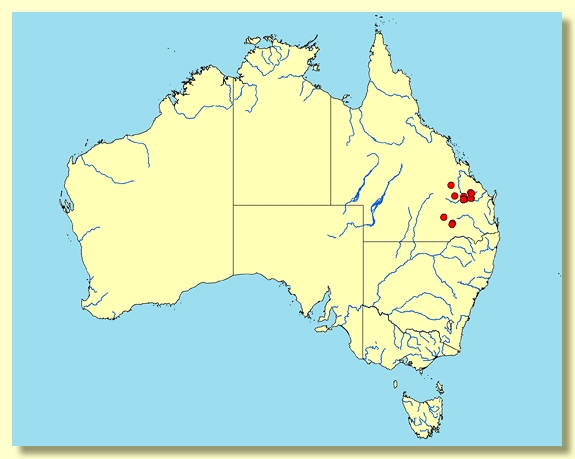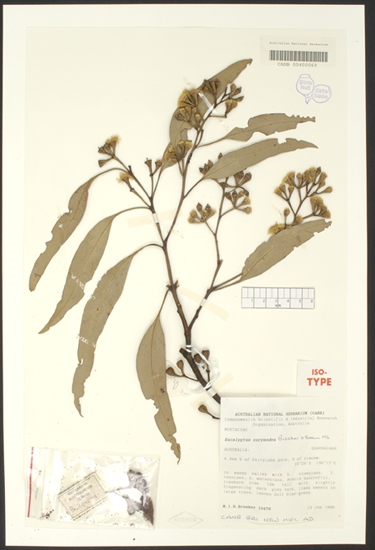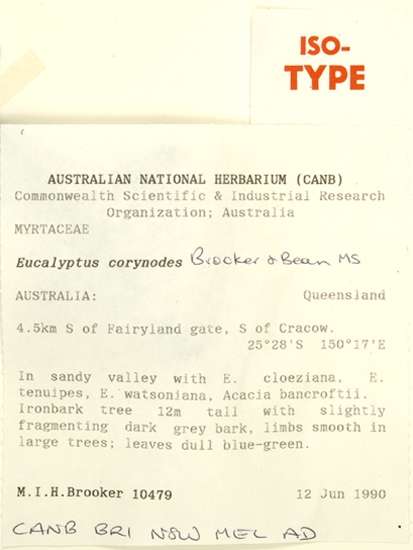Eucalyptus | Symphyomyrtus | Adnataria | Terminales | Rhodoxylon | Concolores
Euclid - Online edition
Eucalyptus corynodes
Tree to 20 m tall. Forming a lignotuber.
Ironbark, dark grey to black. Branches ca 5 cm diameter or narrower often smoothed-barked. Branchlets sometimes glaucous with oil glands sometimes present in the pith.
Juvenile growth (coppice or field seedlings to 50 cm): stem round to square in cross-section; juvenile leaves opposite for a few pairs, petiolate, becoming alternate, lanceolate, 6–9.5 cm long, 1.5–3.5 cm wide, glaucous.
Adult leaves alternate, petiole 1.5–3(3.5) cm long; blade lanceolate to broadly lanceolate to falcate, 8–17 cm long, 1.5–3.5 cm wide, base tapering to petiole, concolorous, dull, grey-green to blue-grey to glaucous, side-veins usually at an angle less than 45° to the midrib, densely to very densely reticulate, intramarginal vein parallel to and well removed from the margin, oil glands sparse and intersectional or often absent.
Inflorescence terminal compound, or axillary compound or sometimes axillary single, peduncles 0.8–2 cm long, buds 7 per umbel, pedicels 0.3–0.7 cm long. Mature buds obovoid, 0.6–0.7 cm long, 0.3–0.4 cm wide, sometimes glaucous, scar present, operculum conical to rounded and often slightly narrower than the hypanthium, stamens inflexed, with outer staminodes, anthers adnate, positioned obliquely at filament tip, cuboid, dehiscing by terminal pores, style long, stigma pin-head, locules 4 or 5, the placentae each with 4 vertical ovule rows. Flowers white.
Fruit sometimes glaucous but this wax fading with age, pedicels 0.2–0.6 cm long, barrel-shaped to cup-shaped, 0.6–0.9 cm long, 0.4–0.8 cm wide, sometimes with longitudinal ribs that become more prominent near the base of the hypanthium, disc descending, valves 4 or 5, enclosed.
Seeds brown, 1–1.5 mm long, flattened-ovoid, shallowly reticulate, hilum ventral.
Cultivated seedlings (measured at ca node 10): cotyledons reniform to oblong; stems square in cross-section, glaucous; leaves always petiolate, opposite for ca 2 to 4 nodes then alternate, lanceolate to broadly lanceolate, 8–13 cm long, 1.7–4 cm wide, base tapering, blue-grey to glaucous.
Flowering has been recorded in April, May and September.
A small to medium-sized ironbark tree endemic to south-east Queensland, preferring sandstone or granite ridges, from the Expedition Range area north-east of Rolleston to west of Eidsvold to the Cracow–Taroom area to west of Monto with a disjunct population in the Roma–Surat area. It is characterised by concolorous dull glaucous to blue-grey adult leaves, terminal inflorescences, buds with staminodes, barrel-shaped to obconical fruit with 4 or 5 valves and lanceolate juvenile leaves.
Within its subgroup of ironbarks, E. corynodes is probably closest to E. melanoleuca and E. suffulgens. Both E. melanoleuca and E. suffulgens differ by having glossy green adult leaves (E. corynodes with glaucous to blue-grey adult leaves). E. melanoleuca differs further by having ovate juvenile leaves (lanceolate in E. corynodes). Other members of this group with glaucous adult leaves, and which could possibly be confused with E. corynodes, are the two subspecies in E. caleyi. They differ by normally having ovate adult and juvenile leaves (lanceolate in E. corynodes). E. caleyi subsp. ovendenii differs further by having distinctly four-sided buds and fruit.
Eucalyptus dura, E. fusiformis, E. tetrapleura, E. panda, E. beyeri, E. virens and E. sicilifolia, also members of this sub-group, all differ by having non-glaucous green adult leaves.
Within its area of occurrence there are other ironbarks, belonging to other groups, which may be confused with E. corynodes. They are E. beaniana, E. crebra, E. decorticans, E. fibrosa subsp. fibrosa, E. fibrosa subsp. nubila, E. melanophloia and E. rhombica, all of which differ in having buds with stamens all fertile and irregularly flexed.
Eucalyptus sideroxylon differs by having buds that hold the outer operculum into maturity and both the inner and outer operculum shed together at anthesis (no operculum scar).
MORE ABOUT IRONBARKS
Eucalyptus corynodes: Greek corynodes, club-shaped, referring to the buds.

